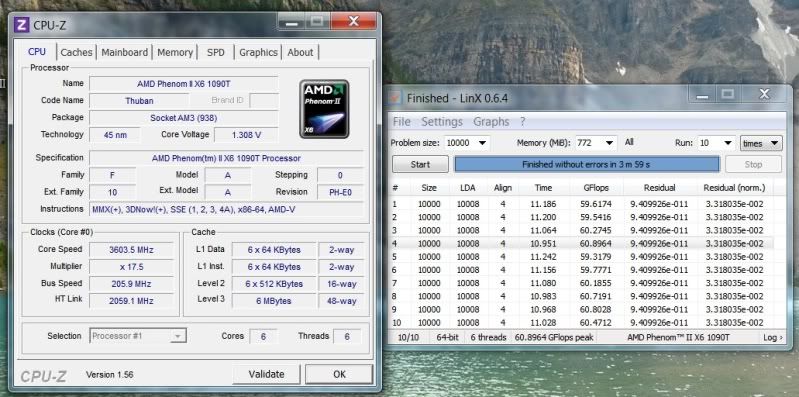*My system and specs are at the bottom for reference.*
-------
I have been fiddling around with some overclocking and when I finished I reverted everything back in the BIOS to AUTO default settings.
I start back up and just to set a benchmark I start running Prime95 without Turbo multiplier un-locker active and no other adjustments on (as far as I know).
I get to running Prime95 for about 10 minutes with the following average readings:
MB Temp: 24c
CPU Temp: 48c
Vcore: 1.25v
All 6 cores are active and the base frequency is up slightly from 200mhz to 200.9mhz for a running frequency of about 3.214ghz.
Everything seems to be running nice and the temperature seems appropriate for the max load with stock cooler... until I suddenly get a warning from CPU-Z that says the' vCore is too high', and when I look at the monitor (part of the ASUS Probe II program) it reads 3.14v for about a second before dropping back down to about 1.25.
It did this twice in the last 30 minutes of running Prime95... as well as once dropping to about 0.50v (estimate since it went away before I could get a good look at it).
Any theories?... and thanks in advance.
-Ham Ninja
----------------------------------
MB: ASUS M4A88TD-V EVO
CPU: AMD Phenom II 1090T 3.2Ghz (stock heatsink unit)
PSU: CoolerMaster Extreme Power Plus 700w
HDD: Maxtor 7200rpm 320GB SATA-II
Windows 7 Pro
-------
I have been fiddling around with some overclocking and when I finished I reverted everything back in the BIOS to AUTO default settings.
I start back up and just to set a benchmark I start running Prime95 without Turbo multiplier un-locker active and no other adjustments on (as far as I know).
I get to running Prime95 for about 10 minutes with the following average readings:
MB Temp: 24c
CPU Temp: 48c
Vcore: 1.25v
All 6 cores are active and the base frequency is up slightly from 200mhz to 200.9mhz for a running frequency of about 3.214ghz.
Everything seems to be running nice and the temperature seems appropriate for the max load with stock cooler... until I suddenly get a warning from CPU-Z that says the' vCore is too high', and when I look at the monitor (part of the ASUS Probe II program) it reads 3.14v for about a second before dropping back down to about 1.25.
It did this twice in the last 30 minutes of running Prime95... as well as once dropping to about 0.50v (estimate since it went away before I could get a good look at it).
Any theories?... and thanks in advance.
-Ham Ninja
----------------------------------
MB: ASUS M4A88TD-V EVO
CPU: AMD Phenom II 1090T 3.2Ghz (stock heatsink unit)
PSU: CoolerMaster Extreme Power Plus 700w
HDD: Maxtor 7200rpm 320GB SATA-II
Windows 7 Pro

